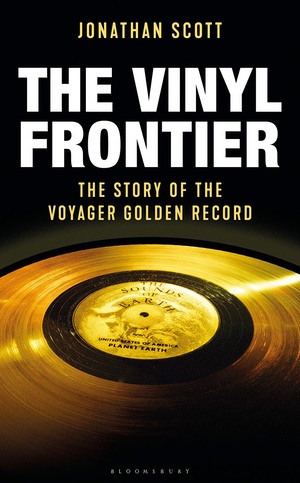Review: The Vinyl Frontierby Jeff Foust
|
| How do you pick the musical pieces and photos to represent humanity, constrained by the limited space on the record, limited time to produce the record, and a budget of less than $25,000? |
Hopefully, nothing will go wrong, and Voyager 2 will operate for several more years before its power supply decays to the point it can no longer operate. Even after that point, though, Voyager 2 will still be communicating: each of the two Voyager spacecraft have a “golden record,” a record with a collection of pictures, music, and greetings intended to offer an overview of Earth in the unlikely event either spacecraft is intercepted by an alien civilization. That record, in the more than four decades since the launch of the two spacecraft, has itself become a cultural artifact, a time capsule of both the planet and the people who created it.
How a small group of people, led by Carl Sagan, created that record is the subject of The Vinyl Frontier by Jonathan Scott, a journalist who has written about both astronomy and music. To him the album is the ultimate mixtape: an encapsulation of humanity in 90 minutes (in the book’s prologue, he compares it to his childhood creation of mixtapes in the 1980s, when they were literally tapes, in the form of cassettes.) It all had to be done on a miniscule budget and a compressed schedule, as well.
But why was there a record on the spacecraft in the first place? Pioneers 10 and 11, the first spacecraft launched on trajectories to take them out of the solar system, included a plaque developed by Sagan, his wife Linda Salzman Sagan, and astronomer Frank Drake. It became famous, or notorious, for its depiction of a nude man and woman. A similar plaque wasn’t in the initial plans for the Voyagers, but project manager John Casani contacted Sagan in late 1976, asking if he could include some kind of message. Some brainstorming with scientists and others—including the likes of Arthur C. Clarke and Robert Heinlein—led to the idea of flying a record that could be filled with music and photos, a much more information-rich depiction of Earth than a plaque.
Much of the book is about the process of creating that record. How do you pick the musical pieces and photos to represent humanity, constrained by the limited space on the record, limited time to produce the record, and a budget of less than $25,000? Sagan’s small team, which included artist Jon Lomberg, writer Tim Ferris, and his fiancée at the time, Ann Druyan, tackled what might seem like an insurmountable challenge, trying to put together as complete a collection as possible.
The challenges were many-fold. What was the right music to include from as many of the world’s cultures as possible? What images best captured our world and society? What sounds? What greetings? Then, once they figured they out, that had to track down permissions to include them on the record, which at times was a challenge: one unnamed person threw Druyan out of his office when she came to ask about a sound collection he had. Sometimes the images they wanted had to be created, as a group at Cornell did on an ad hoc basis to illustrate eating. “I believe that my tongue is immortalized in space because I was available and sitting at my desk the day of the photo shoot,” one participant recalled.
Everything came together, of course, at the last minute, like so many other projects. The product was one that was largely an optimistic view of society: “The Voyager Golden Record was going to show humanity on a good day,” Scott writes. Of course, nothing is perfect: one of the greetings included in the record offered a concise and uplifting message from the secretary general of the UN, Kurt Waldheim—whose Nazi history would become known only several years after the Voyagers left Earth.
| “I believe that my tongue is immortalized in space because I was available and sitting at my desk the day of the photo shoot,” one participant recalled. |
The Golden Record’s audience was, in principal, any alien civilization that might come across it. Lomberg, for example, says he still thinks about the record from the perspective of those hypothetical aliens. In practice, though, the record’s real audience was us, and it has had a far greater effect on us than on any hypothetical aliens who come across it. After all, by the time the records launched, Sagan and Druyan had become a couple, later marrying.
And what of the record itself? Scott, a record collector who interjects throughout the book about his own experience playing in bands and creating mixtapes, offers a few critiques: he’s not fond of passage from Stravinsky’s “Rite of Spring” included in the record, but a Beethoven piece, Cavatina from String Quartet No. 13, gets a ringing endorsement.
“Another point I’d like to make is a simple one: this about how bad this record could have been,” he writes near the end of the book. “The whole thing could have been absolutely strangled by committee, or could have become sponsored and commercialized, turned into little more than a record-label advertisement or back-catalogue sampler.” So, perhaps, the Voyager Golden Record did show humanity on a good day after all.
Note: we are temporarily moderating all comments submitted to deal with a surge in spam.
